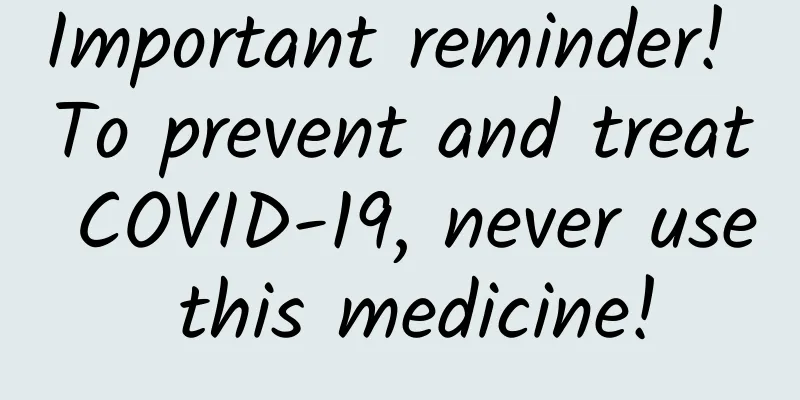Important reminder! To prevent and treat COVID-19, never use this medicine!

|
Currently, if you open your Moments and don’t see one or two messages about COVID-19, it seems to indicate that there is something wrong with your social life… As our understanding of the new coronavirus deepens, everyone has a plan for what to do after testing positive: adjust their mindset, develop good hygiene habits, prepare some relevant medicines and reagents, etc. When it comes to preparing medicine, many people will prepare some cold medicines and antibiotics, thinking of using antibiotics to "reduce inflammation" after cold symptoms appear. In fact, more than 90% of cold symptoms do not require the use of antibiotics . Cold symptoms are manifestations of upper respiratory tract infection. Common colds or "yang" are caused by viruses. Antibiotics can only eliminate bacteria but not viruses. Antibiotics are only used when symptoms such as yellow purulent nasal discharge or coughing up yellow purulent sputum appear, physical examination shows purulent coating in the pharynx , and blood tests show elevated white blood cells , and it is clear that a bacterial infection has occurred after a cold. Some people do not want to spend energy to find out the source of infection. Taking antibiotics will not delay the disappearance of cold symptoms anyway. Now that you have seen the drug resistance of bacteria, will you still use antibiotics indiscriminately? 01 Antibiotic use Antibiotics are substances that can interfere with the developmental functions of living cells . They are produced by microorganisms or higher animals and plants and are a type of secondary metabolites with anti-pathogen or other activities. The antibacterial mechanisms of antibiotics mainly include: inhibiting the synthesis of bacterial cell walls, changing the permeability of bacterial cell membranes, affecting bacterial cell protein synthesis, inhibiting bacterial nucleic acid synthesis or hindering folic acid synthesis. The discovery of antibiotics is a great discovery in the medical field, and the application of antibiotics is a milestone in the history of human anti-infection. Penicillin is the first antibiotic to be discovered, extracted and applied. Since the British bacteriologist Fleming discovered penicillin in Penicillium in 1929, it was used to prevent war wound infection during World War II, and now nearly 100 antibiotics are widely used in clinical practice. The morbidity and mortality of human bacterial infectious diseases have dropped significantly, saving the lives of many patients with severe infections. 02 Emergence of bacterial resistance What is bacterial drug resistance? Bacterial drug resistance is a phenomenon in which bacteria are no longer sensitive to antibiotics or antimicrobial drugs , resulting in reduced clinical drug efficacy or treatment failure . It is a manifestation of bacterial adaptation to the environment. Once drug-resistant bacteria appear, some previously very effective antibiotics will gradually lose their effectiveness against the same people and the same diseases. After use, the fever caused by the infection will not subside, and the infection focus will not shrink or disappear. Due to the irregular use of antibiotics, a serious situation of bacterial resistance has emerged in recent years, and even cross-resistance and multi-drug resistance have occurred. Many or even all antibiotics currently in use face the problem of bacterial resistance, and newly developed antibiotics will also show resistance immediately after they are put into clinical use. The "superbugs" we have heard of are bacteria that are resistant to multiple antibiotics. This type of multi-drug resistant bacteria can have a strong resistance to antibiotics and can escape the danger of being killed. Globally, about 700,000 deaths are related to bacterial resistance each year. The World Health Organization predicts that by 2050, the number of deaths caused by bacterial multidrug resistance will increase to 10 million, which will exceed the number of deaths from cancer and become one of the main causes of death in the world. 03 Causes of bacterial resistance How do cunning bacteria acquire drug resistance under the strong pressure of antibiotics? There are four main mechanisms: producing inactivating enzymes to decompose or inactivate antibiotics, changing the target of antimicrobial drugs, changing cell structure to prevent antibiotics from entering, and relying on efflux pumps to accelerate the excretion of antibiotics out of the cell. So how do bacteria learn the above-mentioned drug-resistance skills? At present, the genetics community believes that there are two ways for bacterial resistance to occur: inherent resistance and acquired resistance , namely, innate and acquired resistance. The former is natural resistance or resistance generated through mutation, which is mediated by bacterial genetic inheritance and is passed down from generation to generation and is difficult to change; while the latter is due to changes in the metabolic pathways of bacteria after direct contact with antimicrobial drugs, making them less likely to be killed by antimicrobial drugs, which is considered to be the main reason for the occurrence of resistance. 04 Is there no cure for bacterial resistance? Inappropriate treatment of bacterial diseases and abuse of antibiotics by humans are the main culprits for the widespread existence of drug-resistant bacteria. According to Darwin's theory of evolution, the development of antibiotic resistance is regarded as an evolutionary process of "survival of the fittest". In order to survive, bacteria gradually develop complex strategies to evade the attack of antibiotics under the "threat" of antibiotics, so the emergence of drug resistance is an inevitable result. The long-term abuse of antibiotics , under the pressure of antibiotics, sensitive strains are constantly killed, objectively reducing the competition in the microbial world , and drug-resistant strains are screened out. Artificial selection has greatly promoted the emergence of bacterial resistant strains. We need to take joint measures in many aspects to cope with the various challenges brought by bacterial resistance, including innovative biomedicine, improving antibiotic use and antibiotic resistance monitoring systems, reducing the rate of antibiotic resistance gene generation, preventing the spread and spread of health care-related infections and multi-antibiotic resistant bacteria, developing rapid microbiological diagnostic methods and equipment, and reducing clinical and veterinary antibiotic abuse. The rational use of antibiotics is the premise for reducing the generation and spread of drug resistance. The principle of antibiotic use is: use narrow-spectrum antibiotics instead of broad-spectrum ones, use low-level antibiotics instead of high-level ones, and use one antibiotic instead of combining several antibiotics when one can solve the problem . 04 How to avoid incorrect use of antibiotics? 1. In daily life, people can easily buy antibiotics through pharmacies or the Internet. Many people use antibiotics immediately when they have a fever or think they have "infection" symptoms. In the long run, this will "cultivate" drug-resistant bacteria. Everyone should use antibiotics correctly under the guidance of a doctor . 2. Do not take antibiotics indiscriminately to prevent diseases . Once drug-resistant bacteria are produced, any antibiotics will be ineffective and the infection will be out of control. 3. Antibiotics are not necessarily better the more expensive they are, because for some pathogens, expensive antibiotics are not necessarily more effective than cheap antibiotics. Each antibiotic has its own specific target bacteria . It is usually recommended to culture bacteria and perform drug sensitivity tests, and select extremely sensitive antibiotics based on the results of drug sensitivity tests. 4. Many people believe that "excessive use of antibiotics will cause bacteria to develop drug resistance" and stop taking the medicine as soon as the condition improves. In fact, not only will the condition recur, but antibiotics will also develop drug resistance when used again. When it is determined that antibiotic treatment is needed, sufficient doses and a full course of treatment should be used . Author: Denovo Review|Liu Lukuan, Associate Researcher, Dalian Medical University |
<<: How should you “eat” after becoming “yang”?
Recommend
Brown discharge after sex
If a woman has brown discharge after sex, it may ...
Is it more painful to deliver a second baby by cesarean section than the first?
We all know that childbirth is the most painful o...
What to do if there are pubic lice in your pubic hair
Many women often find that there are pubic lice o...
Intrauterine bleeding treatment
If intrauterine bleeding is not effectively treat...
What medicine to use for sunburned skin
When the weather is hot, even if we take various ...
With breakthrough infections occurring frequently, should we get booster shots?
A new round of "tour group COVID-19 infectio...
Why do women sweat a lot due to physical weakness?
Many modern people are under great pressure at wo...
Symptoms of irregular menstruation
I believe that every female has experienced irreg...
What is the fragrance of osmanthus? Can the osmanthus on the roadside be eaten?
Among the ancient Chinese poems about flowers, th...
Gynecological examination epithelial cells 1 plus
Gynecological diseases are one of the biggest tro...
What kind of eyebrows should I get for my face shape?
More and more people pay more attention to the ch...
What is the breast enhancement cream method
Is it a good massage technique to use breast enha...
What is the reason for less vaginal water and what are the causes of vaginal dryness?
Psychological factors, excessive stress, frequent...
5 months pregnant, lower body pain
In the fifth month of pregnancy, if there is wate...
What causes vaginal itching due to increased leucorrhea?
Some women have a lot of embarrassing things in t...









